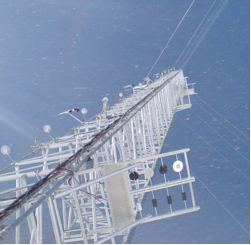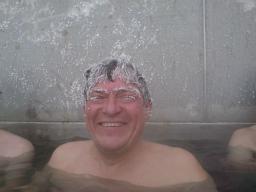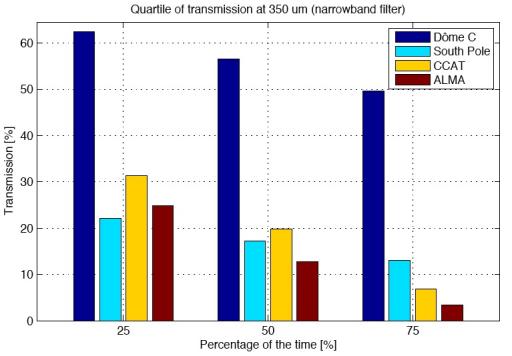The page presents the site testing experiments that are designed and operated by Service d'Astrophysique/CEA Saclay and SIS/CEA Saclay, in partnership with LUAN/Nice, IPEV, and Roma 3.
Submm astronomy is the prime technique to unveil the birth and early evolution of stars and galaxies in the local and distant Universe. Preliminary meteorological studies and atmospheric transmission models tend to demonstrate that Dome C might offer atmosphere conditions that open the 200 micron windows, and could potentially be a site for a large ground-based telescope. However, Dome C climate conditions might also severely impact and deform any telescope mirror and hardware.
Is Dome C really the best site on Earth for the installation of a large submm-wave telescope ? How does the polar environment impact hardware? A site testing campaign in wintertime has specifically been designed for FIR/submm astronomy.
Three prerequisites are now tested at Dome C before launching (or not) any advanced concept study:
(1) whether the submm/THz atmospheric windows open from 200 micron during a large and stable fraction of time;
(2) the knowledge of the thermal gradient and
(3) icing formation and their impact on a telescope mirror and hardware.
GIVRE - DEFROSTING SYSTEM FOR COCHISE AND HARDWARE
Dome C climate conditions severely impact and deform any telescope mirror and hardware. Whatever the telescope at Dome C the combination of little wind and high heat lost by radiation during the polar winter, results into a large thermal inversion and strong icing on all hardware objects. Our team currently tests different ways of protecting the instruments against frost.
16 temperature and wind measurements are performed from 0 to 46m, with closer altitude resolution near the ground. On an aluminium blade, we shall blow a 0.4x0.6 m2 glossy aluminium disk with fresh air blown from the ground in order to check if dry air may clean a surface in altitude (Figure 7).
The COCHISE telescope (Roma 3 University) has been equipped by a system that will monitor the formation of frost on the telescope primary mirror and will try to stop its formation by heating for instance (Figure 9).
The measurements in process at Concordia will describe how much the air is super saturated at 5m and 30m. The strong temperature gradient blocks the air mixture. During 2007 winter campaign, the frost probes at 7m-altitude indicated super saturation of 75% above 100%.
This is highly important as frost forms very quickly at Dome C on any piece of hardware. In the perspective of unmanned telescopes during polar winter, automatic removal of frost will be necessary for all type of telescope.

46m tower equipped with GIVRE experiment. The temperature cells can be seen on the left of the tower. The frost cells are placed on two platform at 5m and 30m on the right of the 46m mast.
GIVRE - TEMPERATURE & WIND ON THE 46m TOWER
Common prerequisites for the design of unmanned telescopes at altitudes up to 46 m include the ongoing measurements of wind, humidity and temperature. Our team currently performs these measurements. The probes consist of 2 horizontal disks (CD like) distant by 10 mm to be used as sun shields. They are black inside, polished aluminium up and down. They are defrosted every 2 minutes for duration of 2 minutes. Inside is placed a thin aluminium cylinder (height 8mm, ø10mm) equipped with a Pt1000 small sensor and a small heater (0.25W) working together with disks heaters. The temperature sensor is red every 10 seconds continuously. Turbulence and air temperature stability might be derived afterward.
SUMMIT2008 AND CAMISTIC: WHAT ATMOSPHERE TRANSMISSION AND SKYNOISE AT 200 µm
A major obstacle to carry out submm observations below 500 microns from ground is the atmosphere as well as the harsh environment of the potential Earth site (high altitude deserts; Antarctica). Preliminary meteorological studies and atmospheric transmission models tend to demonstrate that Dome C might offer atmosphere conditions that open the 200-µm windows. A submm tipper, SUMMIT2008 in collaboration with UNSW/Sydney, has started operating in early 2008 for measuring sky opacity at 200 microns.
The CAMISTIC project aims to install a filled bolometer-array camera with 16x16 pixels on a small telescope, possibly the IRAIT telescope (Tosti et al. 2006), at Dome C. CAMISTIC will explore the 200-µm (i.e. THz) windows for ground-based observations. CAMISTIC will perform site testing on the atmospheric transmission and sky noise in the 200-µm range. Sky noise measurements will be performed through sky imaging with the whole bolometer array. On a 80-cm telescope (IRAIT), the near field is located at 1.6 km for 200 µm. This means that the overlap between the bolometer pixel beams will be greater than 50% until about 1 km, and above the near-field limit, the pixel beams completely diverge. If the water vapour cells responsible for the fluctuations in the atmosphere background power (i.e. sky noise) are located below about 1 km, the pixels "see" through the same atmosphere column and sky noise. However, if these water vapour cells are above 1.6 km, then non adjacent pixels on the array "see" through different atmosphere column and can potentially provide a map of the sky noise.
Preliminary studies have started to interface CAMISTIC with PILOT. PILOT is a 2.4m wide-field optical/infrared telescope planned for Dome C that could also host a submm imager (Burton et al. 2005). To take advantage of the unique site conditions, it will be on a tower above most of the turbulent boundary layer, it will be thermally controlled, it will have fast tip-tilt guiding, and it will have diffraction-limited optics across the 1 degree field (see Saunders et al., this volume).




